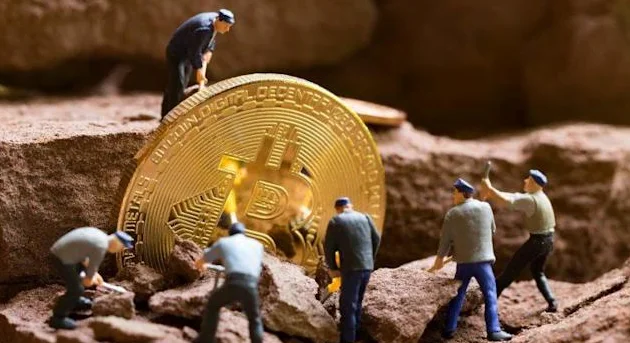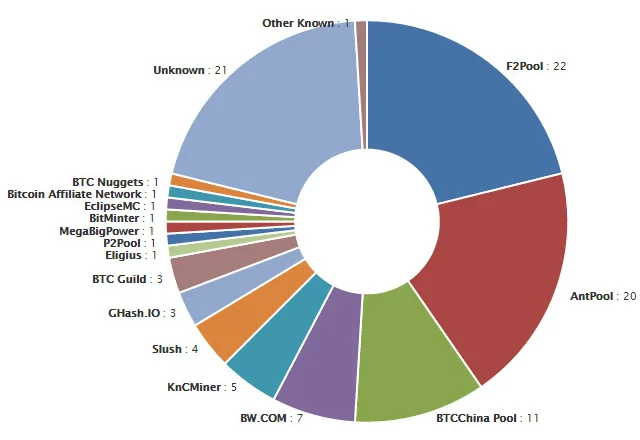Mining Bitcoin can be done individually as a solo miner or collectively in the form of a mining pool. This article gives a detailed explanation of what Bitcoin mining pools are, how they work, and their benefits.

Bitcoin mining pools are networks of distributed Bitcoin miners who cooperate to mine blocks together and distribute the payments based on each entity’s contribution to the pool.
There are two categories of Bitcoin miners. We have the solo miners and the pool miners. The solo miners have their own devices which they use for mining Bitcoin but the pool miners or Bitcoin mining pools as mentioned above are a collection/group of miners who cooperate to maximize their chances of discovering a block collectively as opposed to individually.
In this article, you will learn more about Bitcoin mining pools and how they work. Fasten your seatbelt and enjoy your journey.
What is Bitcoin Mining?
A global network of computers running the Bitcoin code collaborates in a process known as “mining” to make sure that transactions are accurate and added to the blockchain of the cryptocurrency in a timely manner.
Cryptocurrency mining is a computationally difficult, puzzle-solving activity that uses a lot of computing power and electricity. The blockchain’s next block is added by the miner who completes the puzzle first, and they also receive the prizes.
Creating new bitcoin (equivalent to finding gold) and validating and uploading transactions to the blockchain’s public ledger are the two tasks involved in cryptocurrency mining. The mining process is controlled and managed by using an internet-connected computer that is frequently outfitted with specialized mining gear and software tools.
To understand more about Bitcoin mining, read
Bitcoin Mining Pools
A Bitcoin Mining pool in relation to bitcoin mining is a collection/group of miners who cooperate to maximize their chances of discovering a block collectively as opposed to individually.

Bitcoin mining pools are collections of dispersed miners who work together to create blocks and divide the rewards according to how much each miner contributed to the pool.
Hash rate, a measurement of the number of the attempts to find a new block is performed per second, and used to measure contribution to a mining pool.
Every time a miner in the pool discovers a block, they give the mining pool organizer the block reward. The coordinator compensates each pool participant according to their contribution to the hashrate after deducting a nominal charge.
A mining pool typically assigns a coordinator the task of managing the miners. To avoid wasting hash power by trying to generate the same blocks repeatedly, they will ensure that the miners are using distinct values for the nonce.
These organizers will also be in charge of distributing the prizes to the participants when they have been divided. Each miner’s effort is calculated using a variety of various methods, and they are then paid appropriately.
Mining Pools Share Rewards
The pool receives a reward for correctly identifying the block hash, which is subsequently divided according to the pool shares method. Shares indicate the amount of labor a specific member’s machine is putting into the mining pool.
Shares come in two varieties: accepted and rejected. Accepted shares show that a pool member’s efforts have made a significant contribution to the discovery of new crypto coins, which are rewarded.
Shares that have been rejected reflect work that does not advance a blockchain discovery and is therefore unpaid for. It counts as rejected work even if a member’s computer completes the task correctly but submits it after the due date for that particular block.
Ideally, a pool participant wants all of their shares to be accepted. However, shares that are rejected are unavoidable because it is impossible for all calculations performed on a member’s computer to be both beneficial for coin discovery and submitted on time.
Members of the pool who accepted shares and contributed to the discovery of a new coin block are rewarded. A share serves only as an accounting technique to maintain the fairness of the compensation distribution; it has no intrinsic worth.
Methods of Bitcoin Pools
There are two types of mining pool and these are:
- Pay-Per-Share (PPS) Pools
- Pay-Per-Last-N-Shares (PPLNS) Pools
Pay-Per-Share (PPS) Pools
Pay-Per-Share is one of the more popular payment plans (PPS). You will be paid a set sum for each “share” you submit under this scheme. A share is a hash that is used to record each miner’s productivity.
Although the payout for each share is small, it eventually adds up. Keep in mind that within the network, a share is not a legitimate hash. It just means that it satisfies the requirements established by the mining pool.
Whether or if your pool solves a block is irrelevant in PPS. The pool operator will undoubtedly charge a significant fee, either upfront from the users or from the eventual block reward, as they assume the risk.
Pay-Per-Last-N-Shares (PPLNS) Pools
Pay-Per-Last-N-Shares is another well-liked strategy (PPLNS). PPLNS, in contrast to PPS, pays miners only after the pool successfully mines a block. The pool examines the most recent N shares submitted when it discovers a block (N varies depending on the pool).
It multiplies the number of shares you’ve submitted by N, subtracts the operator’s cut from the result, then divides the result by the block reward to determine your payout.
Let’s use an illustration. The possible reward for miners is 10 BTC if the current block reward is 12.5 BTC (assuming no transaction fees) and the operator’s fee is 20%. If N was 1,000,000 and you contributed 50,000 shares, you would get 5% of the payout (or 0.5 BTC).
These two methods come in a variety of forms, but they are the ones you will hear about the most frequently. While we’re talking about Bitcoin, keep in mind that the majority of well-known PoW cryptocurrencies also have mining pools. Zcash, Monero, Grin, and Ravencoin are a few examples.
Choosing a Mining Pool
When choosing a Mining Pool, there are things you need to consider. These are very important as they are essential for a pool miner.
- Payments and Fee Deduction
- Rewards Distribution
- Currency Difficulty Level
Payments and Fee Deduction
When choosing which mining pool to join, please take into account how each pool divides its payments and what fees it deducts. The normal range of deductions is between 1 and 10 percent, while some pools make no deductions at all.
Rewards Distribution
Mining pools have a variety of ways to distribute rewards, but the majority of them are based on how many shares a miner has contributed as proof of effort. Shares are a very tough notion to grasp, but one must remember that mining is a process that involves solving challenging cryptographic challenges.
Currency Difficulty Level
A mining pool also establishes a difficulty level that ranges from 1 to the currency difficulty. If the difficulty level of the block falls between that of the mining pool and the currency, it is counted as a share. Despite being useless, these share blocks are recorded as evidence of work to demonstrate that miners are making an effort to solve blocks. Furthermore, these share blocks display the amount of processing power they are adding to the pool. In the end, a miner can produce more shares the better the gear.
Benefits of Bitcoin Mining pool
There are several benefits to mining this digital currency via mining pools. These include;
- It enables people to mine profitably and generate steady income: Because of this, utilizing mining pools keeps the decentralization of digital currency from being completely under the authority of large corporations.
- It is considerably more challenging to coerce: Although mining pools constitute a centralizing factor, it is also significantly more difficult to coerce them because they are made up of numerous decentralized organizations. To provide their members greater returns than other mining pools, they must continually compete.
- Members can immediately switch to another pool with better procedures if a mining pool starts charging exorbitant fees, acting dishonestly, or censoring transactions and losing out on profit.
Conclusion
The possibilities of realistically making money from individual mining are dwindling as mining becomes more and more popular, helped by high-speed equipment compatible with household computers using a mining pool.
